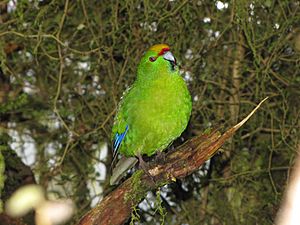Yellow-crowned parakeet facts for kids
Quick facts for kids Yellow-crowned parakeet |
|
|---|---|
 |
|
| In captivity | |
| Conservation status | |
| Scientific classification | |
| Genus: |
Cyanoramphus
|
| Species: |
auriceps
|
The yellow-crowned parakeet (Cyanoramphus auriceps) is a bright green bird that lives only in New Zealand. It's found on the main islands like North Island, South Island, and Stewart Island/Rakiura, and also on some smaller islands like the Auckland Islands. Its special Māori name is kākāriki. Sadly, these parakeets have become fewer because of animals like stoats that were brought to New Zealand. But they are still the most common parakeet on the main islands.
Contents
Where They Live and Why They Need Help
Yellow-crowned parakeets used to live all over New Zealand, on both the big and small islands. But over the last few decades, their numbers have gone down a lot. This is because of two main reasons:
- Animals like stoats, which were brought to New Zealand, hunt these birds.
- People have also cut down too many trees, which means the parakeets lose their homes.
Even though they are not as common as they once were, yellow-crowned parakeets are still the most common parakeet in New Zealand. They prefer to live high up in the trees of thick forests. Sometimes, they are also seen in high grassy areas or on some of the colder subantarctic islands. Living high in the trees might help them stay safer from predators on the ground. These parakeets are special because they are found only in New Zealand.
About Their Name
This parakeet was first described in 1820 by a scientist named Heinrich Kuhl. He gave it the scientific name Psittacus auriceps back then.
What They Look Like
Yellow-crowned parakeets are about 23 cm (9 inches) long. They are mostly bright green. They have a red band across the front of their head, just above their bright yellow (golden) crown. When they fly, their wings look bluish-purple. Their eyes can be orange or red, and their beak is grey.
Male yellow-crowned parakeets are bigger than the females. You can also tell females apart because their beaks are smaller in comparison to their body size.
What They Eat
Yellow-crowned parakeets mostly eat seeds from trees like beech, flax, and tussock grass. They also enjoy eating fruits, flowers, leaves, new shoots, and even small bugs.
Reproduction
These birds build their nests in different places. They might use cracks in trees, burrows in the ground, or hollow tree trunks. This depends on where they live. Their eggs are always white.
See also
 In Spanish: Perico maorí cabecigualdo para niños
In Spanish: Perico maorí cabecigualdo para niños



